What’s the buzz on bees at the Cowichan Preserve?
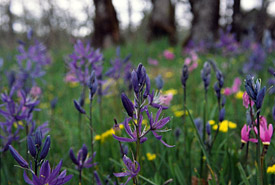
Cowichan Garry Oak Preserve flowers, BC (Photo by Tim Ennis/NCC)
You’ve probably seen it in the news: bees are in trouble. There has been a lot of press about managed honeybees that have been introduced to North America for pollination and honey. Unfortunately, we also know that many wild bees are also experiencing population declines, and some, unlike honeybees, have a real risk of becoming extinct.
Mostly, though, we just don’t know what is happening with wild pollinators. We have more than 800 species of bee in Canada, and 450 in BC, and the vast majority of those species simply haven’t been assessed.
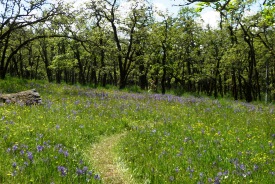
Cowichan Garry Oak Preserve, BC (Photo by Elizabeth Elle)
A decade ago I changed my focus from the plant side of pollination biology to the animal side. Working in the beautiful and endangered Garry oak ecosystem of BC’s coast inspired me to ask questions about what our pollinators were, and which species of wildflowers they pollinate. I was interested to know more simply because I find natural history fascinating, but also figured learning more about pollinators would be a way to “give back” some of my scientific expertise by helping to understand and protect this amazing ecosystem.
Back then no one really knew what species of bees even occurred in BC. Even though I had been studying pollination in BC for five years, I was also fairly clueless about the diversity of bees here. I could tell a bumble bee from a mason bee (large and fuzzy vs. small and metallic blue or green), but that was about it.
Turns out we have six common species of bumble bee in southwestern BC, and more than 30 species of mason bees! These days I’m considered the western Canada expert on bees (!), and it has been an amazing and enlightening journey.
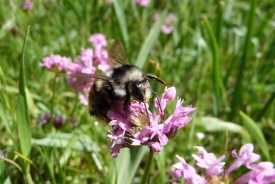
Two-ranked bumble bee on sea blush (Photo by Elizabeth Elle)
My students and I have learned that smaller fragments of Garry oak ecosystem (GOE) have fewer bees than larger ones, and that pollination deficits for some wildflowers seem to be greater in the small fragments. We also have learned that urban and suburban neighbourhoods near GOE fragments can be excellent reservoirs of pollinator diversity because of the food (flowers) they provide (my conservation message to you: plant a garden!!!).
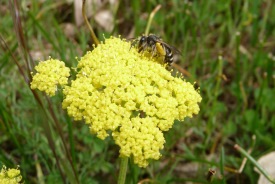
Mining bee on spring gold (Photo by Elizabeth Elle)
Of course, not all bees do well in gardens; we have found that bees that specialize on just one plant species or are particular about their nest requirements are largely restricted to GOE fragments. An example of this includes two species of mining bee, which (as we recently documented) specialize on plants in the carrot family, like spring gold and indian consumption plant.
So, how ARE the bees doing? I get asked this question a lot and it is hard to answer. We know the sestern bumble bee has been declining substantially for years, but after seven years of looking we finally saw this species near Victoria in 2012 (it was a pretty exciting day!).
At the same time, we know that the yellow-fronted bumble bee is actually increasing in BC — we have no records of it from those early years of sampling and now it’s one of our more common species.
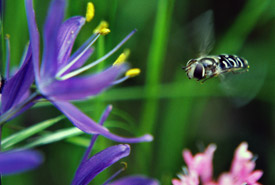
Camas and fly (Photo by Tim Ennis)
The challenge is that we have perhaps 150 bee species in the Garry oak ecosystem, most of which aren’t as charismatic or easy to identify as bumble bees! We just don’t have enough information on most of our bees. And then there are all the other flower visitors — hover flies, wasps and even the occasional beetle or butterfly!
So, I’ve mobilized my team to get some data! In 2005, I sampled pollinators using pan traps at eight sites, including the Nature Conservancy of Canada’s Cowichan Garry Oak Preserve, near Duncan. I documented 85 species of bee, fly, wasp, and butterfly at the Preserve back then, including a mason bee that was new to science. This year, to mark the tenth anniversary of our bee research, we are doing it all again. We started trapping pollinators in mid March of this year, and we’ll continue until the bloom of the wildflowers is over, likely mid July. Then comes the fun part, back at the lab—sorting and identifying all the insects we collect to species. We’ll see which species we’ve gained or lost—and maybe we’ll get enough of that “new” species of mason bee for my taxonomist colleagues to finally name and describe it formally!
Meet Elizabeth and her bees at the In Bloom Wilflower Festival at the Cowichan Garry Oak Preserve in Duncan on Saturday May 9th.


